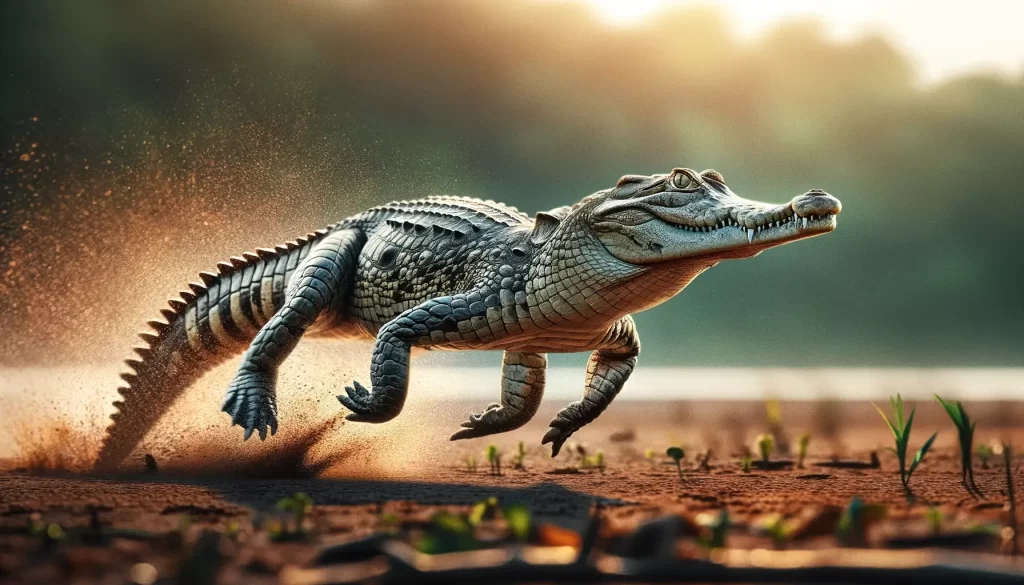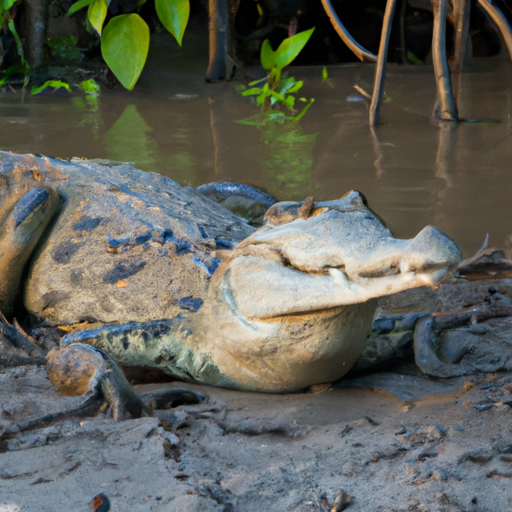
Have you ever wondered how fast a crocodile can run? In this article, you will discover the surprising speed of these ancient reptiles.
From their powerful muscular bodies to their stealthy hunting techniques, crocodiles are built for both land and water.
Get ready to be amazed as we uncover the incredible speed at which these fearsome creatures can move.
Overview
Crocodiles are fascinating creatures with unique physical characteristics, intriguing behavior, and impressive hunting skills.
In this article, we will explore the speed and locomotion of different crocodile species, such as the Nile crocodile, saltwater crocodile, and the American crocodile.
We will also compare the speed of crocodiles with other reptiles, mammals, and birds.
Additionally, you will discover some record speeds and anecdotal evidence about these incredible creatures.
Physical Characteristics
Crocodiles have a distinctive appearance that sets them apart from other reptiles. They have long, powerful bodies covered in tough, scaly skin that provides excellent protection.
Their muscular tails serve as a primary means of propulsion in water and contribute to their speed.
Crocodiles also have strong jaws adorned with sharp teeth that aid in capturing and subduing their prey.
Habitat
Crocodiles can be found in various habitats around the world, including rivers, lakes, swamps, and estuaries. Different species inhabit different locations, depending on their adaptations and preferences. These reptiles are well-suited for both freshwater and saltwater environments, allowing them to thrive in diverse ecosystems.
Behavior
Crocodiles are known for their remarkable behavior, including basking in the sun to regulate body temperature, building nests for their eggs, and engaging in territorial displays. They are also solitary creatures, with the exception of the American crocodile, which sometimes forms small social groups. Despite their perception as slow and lethargic, crocodiles can demonstrate bursts of incredible speed when necessary.
Prey and Hunting
Crocodiles are apex predators, and their diet primarily consists of fish, birds, mammals, and other reptiles. To catch their prey, crocodiles employ a combination of stealth, patience, and lightning-fast strikes. They lie in wait, partially submerged in the water, and launch themselves at their unsuspecting prey with remarkable accuracy and force.
Locomotion
The locomotion of crocodiles is a marvel of nature. On land, they move by lifting their bellies off the ground and using their strong, stocky legs to propel themselves forward in a “sprawling” gait. In water, crocodiles demonstrate extraordinary skill and agility by using their tails to move in an undulating motion, propelling themselves through the water with surprising grace and speed.
Crocodile Speed
Different Crocodile Species
While all crocodile species exhibit similar locomotion abilities, there are slight variations in their speed due to differences in their physical characteristics and habitats. Let’s explore some specific crocodile species and their speed ranges.
Factors Affecting Speed
Several factors influence the speed of crocodiles. These include their size, species, age, environmental conditions, and motives. Generally, larger crocodiles have the potential to achieve higher speeds due to their increased strength and body mass. Furthermore, younger crocodiles tend to be faster than their older counterparts.
Nile Crocodile
Physical Features
The Nile crocodile, one of the most well-known crocodile species, possesses physical attributes that contribute to its impressive speed. It has a streamlined body, a long tail, and powerful jaws. These traits enable the Nile crocodile to swiftly move through water and pursue its prey with precision.
Speed Range
The speed range of a Nile crocodile varies depending on the circumstances. While it can maintain a cruising speed of around 6 to 12 miles per hour (10 to 20 kilometers per hour), it has been observed reaching remarkable sprinting speeds of up to 20 miles per hour (32 kilometers per hour) when launching an ambush or pursuing prey.
Sprinting Speed vs. Cruising Speed
The Nile crocodile’s sprinting speed far exceeds its cruising speed. It is important to note that despite its ability to reach high speeds in short bursts, the Nile crocodile is not designed for sustained long-distance chases. Its sprinting speed is primarily used to surprise and capture prey, ensuring a successful hunt.

Saltwater Crocodile
Physical Features
The saltwater crocodile, also known as the estuarine crocodile, is the largest living reptile and possesses physical features that contribute to its formidable speed. It has a robust body, a powerful tail, and a strong jaw. These characteristics enable the saltwater crocodile to swiftly navigate through its aquatic environment.
Speed Range
The saltwater crocodile is renowned for its incredible speed. It can maintain a cruising speed of about 9 to 12 miles per hour (15 to 20 kilometers per hour) while swimming steadily. However, when it comes to short bursts of speed, this mighty reptile can reach astonishing velocities of up to 18 to 22 miles per hour (29 to 35 kilometers per hour) while launching an attack or defending its territory.
Burst Speed
The burst speed of a saltwater crocodile is particularly impressive, making it a formidable predator. When in pursuit of prey or engaged in territorial disputes, this crocodile can accelerate rapidly and unleash a burst of speed, often catching its target off guard and securing a successful outcome.
American Crocodile
Physical Features
The American crocodile, inhabiting parts of the Americas and the Caribbean, possesses unique physical features that contribute to its speed and maneuverability. It has a slender body, a long tail, and powerful jaws. These characteristics enable the American crocodile to navigate through its diverse freshwater and estuarine habitats with ease.
Speed Range
The American crocodile has a moderate speed range compared to its larger counterparts. It can maintain a cruising speed of approximately 8 to 10 miles per hour (13 to 16 kilometers per hour) while swimming calmly. During brief bursts of energy, it can reach speeds of up to 14 miles per hour (22 kilometers per hour), allowing it to capture prey or escape from potential threats.
Agility and Maneuverability
Although the American crocodile may not possess the same top speed as other crocodile species, it compensates with its exceptional agility and maneuverability. Its slender body and long tail enable it to navigate through intricate environments such as mangroves and narrow water channels, ensuring successful hunting and survival.
Other Crocodile Species
More About Different Crocodile Species
In addition to the Nile crocodile, saltwater crocodile, and American crocodile, there are various other fascinating crocodile species found around the world. Each species possesses unique physical characteristics and adaptations that contribute to their individual speed capabilities.
Comparisons of Speed
While the Nile crocodile, saltwater crocodile, and American crocodile are widely recognized for their speed among various crocodile species, it is vital to appreciate the specific traits and environments of each species that contribute to their differing speed ranges. Comparing the speed of these magnificent creatures provides valuable insights into the varied adaptations and survival strategies within the crocodile family.
Crocodile vs. Other Animals
Comparisons with Other Reptiles
Crocodiles possess impressive speed when compared to other reptile species. Their ability to reach high velocities in water distinguishes them from most reptilian counterparts, making them efficient hunters and formidable predators.
Comparisons with Mammals
While crocodiles may not reach the same speeds as certain mammals, they compensate with their significant size, strength, and ambush tactics. The explosive bursts of speed exhibited by crocodiles enable them to overpower prey effectively, making them dominant predators in their respective ecosystems.
Comparisons with Birds
Crocodiles cannot match the high-speed capabilities of many bird species. However, their ability to move swiftly in water allows them to pursue and catch some bird species when they come into their hunting range. The interaction between crocodiles and birds showcases the complex dynamics of predator-prey relationships in the animal kingdom.
Record Speeds and Anecdotal Evidence
Reported Record Speeds
Determining the exact speed of a crocodile in the wild is challenging due to various factors and limitations. However, there have been anecdotal reports documenting impressive instances of crocodile speed. Some sources suggest that crocodiles can attain speeds of up to 30 miles per hour (48 kilometers per hour) during short bursts.
Controversies and Limitations
It is important to note that reported record speeds of crocodiles are often surrounded by controversies and limitations, as accurately measuring their speed in the wild poses significant challenges. Factors such as the experimental conditions, individual variations, and the unpredictability of the animals themselves make it difficult to obtain precise and universally accepted data.
Final Thoughts
Crocodiles, with their unique physical characteristics and astonishing speed, truly deserve admiration.
From the Nile crocodile’s impressive sprinting abilities to the saltwater crocodile’s burst speed, these reptiles showcase extraordinary locomotion skills.
Although there are controversies and limitations surrounding reported record speeds, it is evident that crocodiles are formidable predators capable of surprising bursts of speed when in pursuit of prey. By exploring the diverse species and comparing crocodile speed to other animals, we gain a deeper understanding of the incredible nature of these ancient and magnificent creatures.



